Hardware Feedback Taxonomy Framework
Achieve project success with the Hardware Feedback Taxonomy Framework today!

What is Hardware Feedback Taxonomy Framework?
The Hardware Feedback Taxonomy Framework is a structured approach designed to categorize and analyze feedback related to hardware products. It provides a systematic way to collect, organize, and interpret feedback data, ensuring that insights are actionable and relevant. This framework is particularly important in industries where hardware performance and user experience are critical, such as consumer electronics, automotive, and industrial equipment. By leveraging this taxonomy, teams can identify recurring issues, prioritize improvements, and enhance product reliability. For example, in the context of consumer electronics, the framework can help categorize feedback into usability, durability, and performance, enabling targeted enhancements.
Try this template now
Who is this Hardware Feedback Taxonomy Framework Template for?
This template is ideal for product managers, quality assurance teams, and customer support professionals working in hardware-related industries. Typical roles include hardware engineers seeking to understand user pain points, customer service teams aiming to streamline feedback collection, and product designers looking to align improvements with user needs. For instance, a product manager at a tech company can use this framework to categorize feedback from beta testers, while a quality assurance team can analyze recurring issues reported by customers to refine testing protocols.

Try this template now
Why use this Hardware Feedback Taxonomy Framework?
The Hardware Feedback Taxonomy Framework addresses specific challenges in managing hardware-related feedback. One common pain point is the difficulty in organizing diverse feedback types, such as performance issues, design flaws, and usability concerns. This framework provides a clear categorization system, making it easier to identify patterns and prioritize actions. Another challenge is ensuring that feedback is actionable; the taxonomy framework translates raw data into structured insights that can guide decision-making. For example, a hardware company struggling with frequent customer complaints about battery life can use this framework to pinpoint the root causes and develop targeted solutions. Additionally, the framework supports cross-functional collaboration by providing a shared language for discussing feedback, ensuring that teams are aligned in their efforts to improve hardware products.

Try this template now
Get Started with the Hardware Feedback Taxonomy Framework
Follow these simple steps to get started with Meegle templates:
1. Click 'Get this Free Template Now' to sign up for Meegle.
2. After signing up, you will be redirected to the Hardware Feedback Taxonomy Framework. Click 'Use this Template' to create a version of this template in your workspace.
3. Customize the workflow and fields of the template to suit your specific needs.
4. Start using the template and experience the full potential of Meegle!
Try this template now
Free forever for teams up to 20!
The world’s #1 visualized project management tool
Powered by the next gen visual workflow engine




